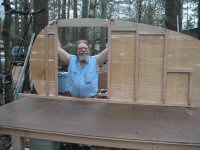 by mskobier » Thu Dec 30, 2010 4:50 pm
by mskobier » Thu Dec 30, 2010 4:50 pm
Russ,
More usefull information. Keep it coming please.
I do not recall for sure, but in one of your previous posts you referenced how many times per night you were getting up to turn the blue flame on. I do remember you stated you were running it for about an hour each time. I do not think you said how long it was between runs of the blue flame. I do think you are correct in that your fuel useage will probably be less than with the blue flame. It will definately be more comfortable and the heat will be more consistent with the new furnace.
You are correct in that I am in a home. Actually, I consider myself very fortunate and truely blessed that my wife and I have a very good jobs. With a little luck, in just a few years, we will be completely out of dept. Then a lot of worrying about the economy and such will go away. As long as one of us can still maintain full time employment, we should be able to make it. Then our cost of living drops through the floor. That will be a very good feeling! However, with the way the economy currently is and will be in the foreseeable future, all of that could change very quickly. That is one of the reasons your experiences in your CT is of interest to me. At least, if things do go south, with our CT conversion, we will still have a roof over our heads. There are an awful lot of people who are not that fortunate. Before I started the CT conversion, I had considered just buying a small travel trailer. Unfortunately, I did not like the quality of construction that I was seeing. So I went the CT conversion way. Minimal creature comforts built on a strong solid platform!
The primary reason I wanted to use a vapor barrier is to protect the plywood walls from whatever moisture finds its way between the plywood and insulation/frame. I know the sheet plastic really gives no insulation value. Its main purpose is to protect the plywood walls from condensation on the steel studs and cut down on what air movement there could be around the EPS insulation sheets. Remember, my trailers wall interiors are open to the outside air under the trailer. I have not fully decided to use the plastic sheeting. I could just use plastic tape over the insulation seams and over the steel where it contacts the plywood.
In looking at the times and number of minutes of each run cycle, it appears that so far you are accounting for only about 2-3 hours of use out of a total of 24 hrs per day. Assuming you are not shutting it off during the day, you are running the furnace about 25% of the time or about a total of about 6 hrs per day. I am sure it does not run nearly as much during the day, but those numbers have not been posted. With that said, you are currently using a little over 1 gallon of propane per day. Again, I think this number is significantly higher than it actually is. So you are now into this for approx three days. Again with the assumptions that it runns the same during the day as it does at night, you will have used about 3/4 of a tank of propane. about 3 gallons. assuming the remainder of the time it only runs for less than half the time it does at night. You are somewhere near 1/2 a tank opf propane used. It will be interesting to see how long it actually takes to use up a tank of propane.
Have you been able to recharge your battery off of shore power or your generator? Using the asumptions above, you should have used about 63 amp hrs out of your battery. Again assuming you have no other dc loads (lights, etc) on that battery. Again, probably less than that with the probable reduced run time of the furnace during the day. You may want to consider recharging the battery if you have not.
Something else to remember about bateries and very cold weather. A fully charged battery generally will not freeze unless the temps get very very cold (sub zero). As a battery discharges, the temperature where a battery will freeze goes up. I forget the estimated numbers, just remember it takes less cold temps to freeze a battery the more discharged it is. With it now being the middle of the winter, and since your heating system now relies on your batteryto work, you may want to consider keeping your batteries as fully charged as practical. Even just recharging them for one hour per day will really help keep the battery from freezing. Now that you have reliable heat, you may also want to consider discontinuing the use of the DC electric blanket and hooking the batteries in parallel to decrease how much each battery gets discharged between recharging cycles.
I do understand the concept that if one battery is weaker than the other you may shorten the lifes of both. If you keep the batteries chaged regularly, this should not be a problem. at least through this winter. You could also install a battery isolator switch like they use on boats to switch between the two batteries.
Well, I better get going. I need to go purchase new tabs for my car. It's a fairly large fine here in Wa state if caught with expired tabs.
Take care
Mitch





